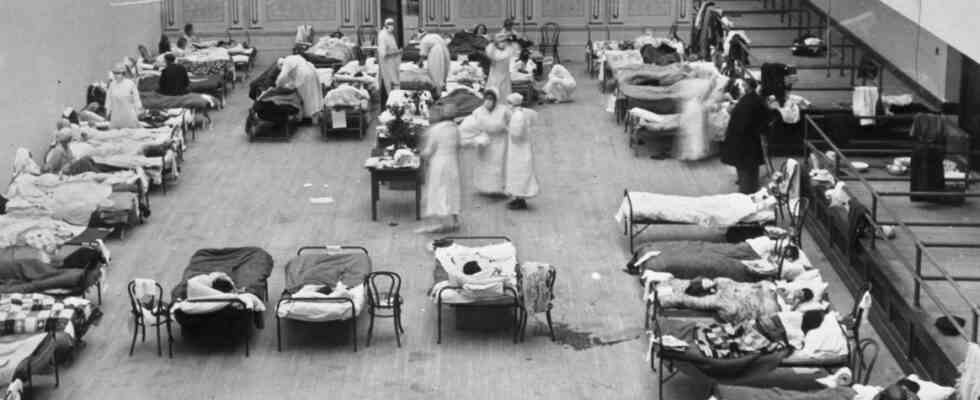Would there be anything worthwhile left in those old lungs? Sébastien Calvignac-Spencer didn’t really have much hope. But the Charité Medical History Museum was so close, almost in the backyard of his employer, that the infection epidemiologist from the Robert Koch Institute (RKI) just stopped by there. Calvignac-Spencer has long been interested in the evolution of viruses, in fact all of the pathogens that have invaded the human respiratory tract over the past 200 years – whether they caused a pandemic or just passed from person to person. But he had not expected that the Berlin museum would have such a virological treasure at its disposal.
Because in the medical-historical collection of the Charité, which was set up in the middle of the 19th century by none other than the great pathologist Rudolf Virchow, there were six lungs or parts of the lungs of people who had died during the time of the Spanish flu – that comprehensive, bestial, probably the largest of all influenza pandemics that have ever afflicted mankind. Between 1918 and 1920, it killed an estimated 50 million people worldwide, and possibly more. And to this day little is known about the virus from back then, especially not whether it – like we now know from the corona virus – has evolved over the course of the pandemic.
In fact, the pathogen that causes the Spanish flu has learned over time to be better at escaping the human immune response, according to the team led by Sébastien Calvignac-Spencer in the specialist journal Nature Communications. Because the researchers found some mutations that indicate this. “Scientists have long wondered what happened to the viruses back then,” says Thorsten Wolff, head of the influenza virus research group at the RKI, “now we can give an answer.”
It was a success they didn’t expect when Calvignac-Spencer first stopped by his colleagues at the museum five years ago. In three of the six samples from the time of the Spanish flu, the team actually found genetic material from influenza viruses. They were able to partially genetically decipher this from two of the samples that came from deceased people in Berlin and even almost completely from a sample from a deceased person in Munich. “At first I thought it wouldn’t work well, but it worked wonderfully from day one,” says Calvignac-Spencer, “the viral genome was surprisingly well preserved.” On average, the fragments were over 100 building blocks long — far longer than the human genome they were able to extract from the lung samples; possibly because the virus genome was better protected in its virus particles. The puzzle was nevertheless complex, because an influenza genome comprises around 14,000 building blocks.
Until the work of the RKI scientists, there were only two fully deciphered genomes of Spanish flu viruses worldwide – one from Alaska, the other from New York. There were a few different building blocks compared to the US viruses, but the genomes of the two Berlin viruses, both of which date from June 1918, differed in only two prominent places. “At this time and in this place, the variability of the viruses was evidently negligible,” says Thorsten Wolff. The Munich virus, on the other hand, was 22 mutations away from the Berlin viruses, and the virus apparently developed during the course of the pandemic. “Mutations were included in the viral genome that are responsible for escaping the human immune system and thus for adapting to the human host,” says Stephan Ludwig, who researches influenza viruses in his Institute for Molecular Virology at the University of Münster and not part of the RKI team.
The genome was isolated from preserved lungs
But the virus did not reinvent itself from scratch. Even the currently circulating influenza viruses, which, like the 1918 virus, are of the H1N1 type, are still very similar to the old pandemic virus. Apparently, they are even direct descendants of the Spanish flu pathogen. Most influenza researchers had already assumed that the seasonal H1N1 viruses descended directly from the 1918 pandemic, says Stephan Ludwig, but with the new work there is now certainty. “Here we have a wonderful example of how knowledge can be gained through the further development of technical possibilities and their clever combination, which previously had to remain unclear for over 100 years,” enthused the virologist to the SZ. It is an achievement to isolate enough viral genetic material from the ancient preserved samples, then to sequence it and to analyze the data with the help of the latest computer algorithms in order to clarify their evolutionary connections.
Influenza viruses are known to swap and rearrange their genes. This happens particularly frequently when several of these pathogens meet in a host, usually in a pig. Because pigs can not only be infected with swine influenza viruses, but also with those of birds or humans. The human H1N1 virus has remained true to itself for a long time. “You can now be pretty sure that no new combination of viruses took place in the H1N1 viruses after the 1918 pandemic,” says Stephan Ludwig. Although H1N1 was silent for 20 years before resurfacing in 1977, it is still a direct descendant of the world’s worst flu. People are just lucky that they have built up good immune protection against this virus over the decades.

